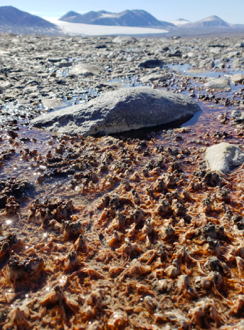 One last goodbye to Polar TREC Polly and Paul. They will be spending the winter together here at the Crary Lab at the McMurdo Station.
One last goodbye to Polar TREC Polly and Paul. They will be spending the winter together here at the Crary Lab at the McMurdo Station.
Weather

Menu

Flight Status
 If all goes as planned, we will board our C-17 tomorrow and head to New Zealand. It's been a wonderful (almost) two months down here, but the time has come to move on to other things at home. Stay tuned for the flight update.
If all goes as planned, we will board our C-17 tomorrow and head to New Zealand. It's been a wonderful (almost) two months down here, but the time has come to move on to other things at home. Stay tuned for the flight update.
Here is episode 5 of "Meet The Scientist" with Sarah Power

Hi, I’m Sarah Power! I’m a MS student at Virginia Tech working with Dr. Jeb Barrett, and this is my second year down on the ice as part of the Wormherders. I’m originally from Gainesville, Florida where I graduated with my BS from the University of Florida in Biological Engineering. My hobbies include hiking and hanging out with my adorable corgi (shout out to Indie!).
A bit about my research:
Outside of the long-term monitoring projects with the Wormherders, I’m also part of another team down here researching microbial mats. Microbial communities form multi-layered sheets, AKA microbial mats, and are made up of mostly cyanobacteria, but also green algae, diatoms, and cute tardigrades. The microbial mats are various colors (black, orange, red, and green) and are found within the glacial melt streams and on the stream margins.
 An orange microbial mat with black mat poking up over the stream water. Both of these mat types are mainly cyanobacteria species.
An orange microbial mat with black mat poking up over the stream water. Both of these mat types are mainly cyanobacteria species.
 A close-up of the same mat.
A close-up of the same mat.
These microbial mats are intriguing to me in how they interact with their environment. They’re able to survive being freeze-dried and desiccated all throughout winter and quickly become active with the onset of stream flow. They’re only active (that is, photosynthesizing) for about 10-12 weeks each year. They also have interesting pigments. Chlorophyll is the pigment that all plants have that allow them to absorb energy from light to photosynthesize. These microbial mats have chlorophyll, and they also have other pigments that are used for protection against the intense ultraviolet light they experience. These pigments are called microbial sunscreen pigments, since they act as a sunscreen for the microbes.
 Black microbial mat with green moss growing on top. The black mats get their color from the sunscreen pigment called Scytonemin. If you flip these mats over, they are green colored on the bottom. Scytonemin is protecting the underlying chlorophyll from the UV!
Black microbial mat with green moss growing on top. The black mats get their color from the sunscreen pigment called Scytonemin. If you flip these mats over, they are green colored on the bottom. Scytonemin is protecting the underlying chlorophyll from the UV!
 Bright orange microbial mat. When the mats are active, their pigments light up! When they’re desiccated, the colors are much duller.
Bright orange microbial mat. When the mats are active, their pigments light up! When they’re desiccated, the colors are much duller.
We’re using imagery taken from the WorldView-2 satellite in space to map out the extent of these microbial mats. The satellite images are processed on computers to show where productivity is occurring. Chlorophyll absorbs most light in the visible light portion of the electromagnetic wavelength spectrum, and it rapidly reflects light in the near-infrared portion of the spectrum. Because of this, image processing software can be used to detect chlorophyll – or microbial mat presence. The satellite flies over daily, but we can only use the images that have no clouds in the photos, since clouds completely block out the scene. Unfortunately for us, this season was particularly cloudy, but we were still able to collect good data!
In the field, we set up several plots and sampled the area for microbial mats. At the same time, Dr. Mark Salvatore and PhD student Schuyler Borges of Northern Arizona University took spectral measurements of the microbial mats using a handheld hyperspectral spectrometer. The satellite produces lower resolution spectral data, while the handheld hyperspectral sensor produces high resolution spectral data. The spectrometer measures the reflectance of light at various wavelengths across the electromagnetic spectrum.
 Dr. Mark Salvatore and Schuyler Borges calibrating the handheld spectrometer using a pure white reference. The field spectrometer is built into a backpack that has straps to hold a laptop. Each time a spectra is taken, the resulting spectral profile graph is displayed on the laptop.
Dr. Mark Salvatore and Schuyler Borges calibrating the handheld spectrometer using a pure white reference. The field spectrometer is built into a backpack that has straps to hold a laptop. Each time a spectra is taken, the resulting spectral profile graph is displayed on the laptop.
Back at Virginia Tech, I will be finishing up my Masters this semester and then starting my PhD in August. I’ll have a few more field seasons down on the ice – I’m definitely hooked on this place!

I was invited to be a guest on McMurdo Station's ICE RADIO, 104.5fm. Here are some clips of my fun visit with Dennis:
 Ice Radio.
Ice Radio.

Add new comment